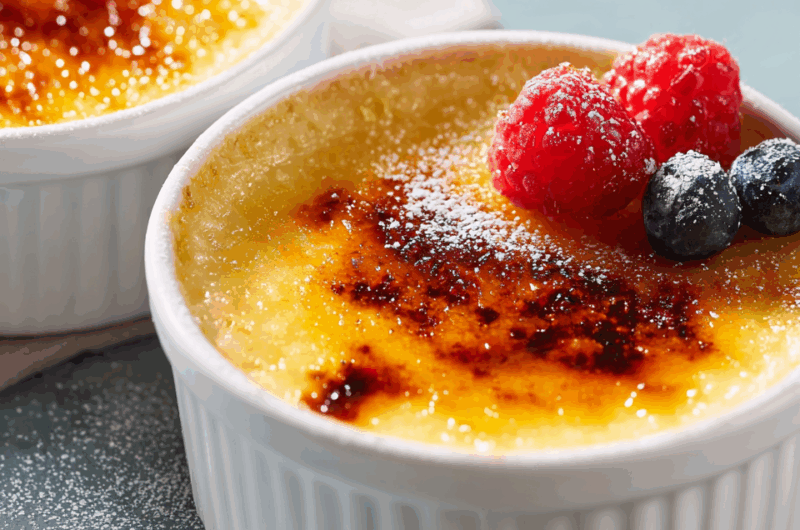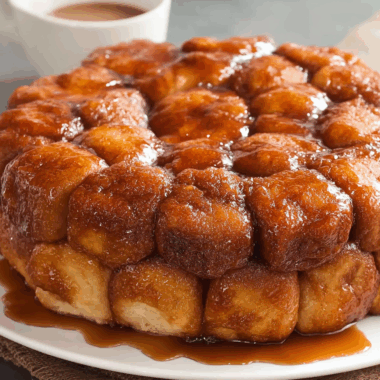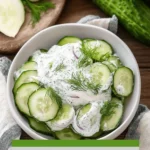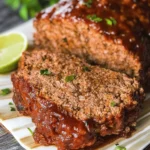This Crème Brûlée recipe is a timeless French dessert that combines silky, vanilla-infused custard with a crisp, caramelized sugar crust. Simple to prepare yet undeniably elegant, it’s the perfect finale to a romantic dinner or special gathering.
You don’t need to be a professional chef to make this show-stopping dish. With just a few ingredients and a kitchen torch, you can achieve that satisfying crack and creamy center right at home. Whether served in classic ramekins or in a more creative presentation, Crème Brûlée never fails to impress with its rich flavor and contrasting textures.
Full Recipe:
-
1 cup heavy cream
-
3 tablespoons white sugar (plus 2 tablespoons for topping)
-
2 large egg yolks
-
1/2 teaspoon vanilla extract
-
Hot water, as needed for the water bath
Directions:
-
Preheat your oven to 350°F (175°C).
-
In a microwave-safe bowl, whisk together the cream and 3 tablespoons sugar until blended. Microwave the mixture until warm (about 1–2 minutes), then whisk again to dissolve the sugar.
-
Whisk in the egg yolks and vanilla extract until the mixture is smooth.
-
Pour the custard into two ramekins and place them in a roasting pan. Pour hot water into the pan until it reaches halfway up the sides of the ramekins.
-
Bake for approximately 50 minutes, or until the custard is set but still slightly jiggly in the center.
-
Remove the ramekins from the water bath and chill in the refrigerator for at least 2 hours, or until fully cold.
-
Just before serving, sprinkle 1 tablespoon of sugar evenly over each custard. Use a kitchen torch to melt and caramelize the sugar until browned and bubbly, about 30 seconds.
-
Allow the sugar topping to cool and harden before serving.
Prep Time: 10 minutes | Cooking Time: 50 minutes | Total Time: 3 hours (includes chilling)
Kcal: 375 kcal | Servings: 2 servings
The Elegance of Crème Brûlée: A French Classic That Never Fails to Impress
Crème Brûlée is more than just a dessert—it’s an experience. With its luxuriously smooth custard base and that signature burnt sugar top that shatters with a satisfying crack, it has become a staple in fine dining menus around the world. But while it might look and taste extravagant, the truth is, Crème Brûlée is surprisingly easy to make at home.
Whether you’re preparing it for a romantic dinner, a holiday gathering, or simply to treat yourself, this French classic offers the perfect blend of texture, flavor, and drama. Let’s dive deep into its origins, how it works, and how you can take this timeless dessert to the next level.
A Brief History of Crème Brûlée
The name Crème Brûlée literally translates to “burnt cream” in French, referring to the torched sugar topping that distinguishes the dessert. While France is most commonly credited with its creation, similar versions have appeared in English and Spanish culinary history.
In England, it was known as “Trinity Cream” and served at Trinity College in Cambridge in the 17th century. Meanwhile, Spain’s version, Crema Catalana, is flavored with citrus zest and cinnamon. However, the French style eventually took the lead in terms of international popularity, primarily due to the rise of fine French patisserie in global culinary culture.
Regardless of its disputed origins, Crème Brûlée has earned its spot as an icon of dessert sophistication.
What Makes Crème Brûlée So Special?
At first glance, Crème Brûlée might seem deceptively simple. It’s made with just a few core ingredients—cream, sugar, egg yolks, and vanilla. But the magic lies in its texture and contrast. The custard should be silky, rich, and just firm enough to hold its shape when spooned. Topping it off is a thin, crackly layer of caramelized sugar that adds crunch and depth.
That dramatic contrast between cold, creamy custard and the warm, glass-like sugar shell makes each spoonful a moment to savor. The sound of the spoon breaking the surface has even become symbolic of the dessert itself—an auditory cue of indulgence.
Understanding the Science Behind the Custard
Making the perfect Crème Brûlée is a balance of culinary science and technique. The custard is a form of egg-thickened dessert where yolks and cream are gently heated to create a smooth, dense texture. Unlike stovetop custards or stirred puddings, this one is baked in a water bath, also known as a bain-marie.
This gentle, indirect heat ensures that the eggs don’t curdle or scramble. The result? A flawless custard that’s creamy yet set. Too hot or fast, and you’ll get bubbles or rubbery texture. Too cold or short on time, and it won’t set at all.
Additionally, using only egg yolks (and not the whites) helps contribute to the richness and smoothness, making it ultra-decadent.
The Sugar Topping: Torch vs. Broiler
No Crème Brûlée is complete without that iconic caramelized top. This final step is what elevates it from a simple custard to a true showstopper. There are two common ways to achieve this: using a kitchen torch or placing the ramekins under a broiler.
Using a torch offers more control and ensures an even caramelization without heating the custard below. It’s fast, precise, and frankly, a lot of fun. Watching the sugar bubble and brown is a small moment of culinary theater right at your dining table.
If you don’t have a torch, a broiler will do—but it requires more attention to avoid burning or melting the custard beneath. Whichever method you choose, the key is to spread the sugar evenly and use superfine sugar if possible—it melts more uniformly and crisps up better.
Crème Brûlée Tips for Home Cooks
Even though it’s considered a “fancy” dessert, Crème Brûlée is very approachable with the right know-how. Here are some pro tips to ensure your results are restaurant-worthy every time:
-
Use fresh, quality cream and vanilla: Since the recipe is minimal, each ingredient stands out. Opt for heavy cream with no additives and pure vanilla extract or real vanilla beans.
-
Strain the custard before pouring into ramekins to ensure a perfectly smooth texture.
-
Bake slowly and gently: A water bath and a moderate oven (around 325°F to 350°F) prevent curdling and overcooking.
-
Chill thoroughly before caramelizing the sugar. The colder the custard, the better the contrast with the warm topping.
-
Torch just before serving to preserve the crisp texture.
Flavor Variations and Twists
While the classic vanilla version remains timeless, Crème Brûlée is incredibly versatile. Once you master the base, you can easily adapt it to suit seasonal flavors or personal preferences.
-
Citrus zest: Add lemon, orange, or grapefruit zest to the cream before baking for a refreshing twist.
-
Lavender or Earl Grey: Infuse the cream with dried lavender buds or tea leaves for a floral or aromatic variation.
-
Chocolate: Stir in melted dark chocolate for a more decadent version.
-
Coffee: Add espresso powder or steep coffee beans in the cream for a mocha delight.
-
Boozy twists: A splash of Grand Marnier, Amaretto, or bourbon adds complexity.
Experimenting with these flavors makes Crème Brûlée even more exciting and customizable.
Serving Suggestions
Crème Brûlée is typically served in shallow ramekins to allow for a greater surface area of caramelized sugar. However, it can be presented in a variety of ways depending on the occasion. Mini ramekins make for delightful tasting portions at a dessert bar, while slightly deeper dishes create a more dramatic spoon-to-mouth experience.
You can serve it plain or pair it with fresh berries, a sprig of mint, or a dusting of powdered sugar around the edge of the ramekin for visual contrast.
The best time to serve it? Straight after torching, when the sugar crust is fresh and crisp.
Why It’s the Perfect Make-Ahead Dessert
One of the greatest strengths of Crème Brûlée is its flexibility with timing. The custards can be prepared and baked a day or two in advance and kept chilled in the fridge. When it’s time to serve, simply sprinkle the sugar and torch it—instant elegance with minimal last-minute effort.
This make-ahead feature makes it ideal for dinner parties and gatherings where you want to serve something impressive without being stuck in the kitchen.
Common Mistakes to Avoid
While the recipe is simple, a few missteps can compromise the final result:
-
Overbaking: Leads to rubbery custard. It should still jiggle slightly in the center when done.
-
Skipping the water bath: Direct heat will scramble the eggs.
-
Caramelizing too far in advance: The crisp sugar will absorb moisture and soften.
-
Using granulated sugar for topping: It can caramelize unevenly—superfine sugar is best.
Avoid these, and you’re on track to Crème Brûlée perfection.
Conclusion: Why Crème Brûlée Belongs in Every Dessert Repertoire
Crème Brûlée is more than just a dessert—it’s a culinary masterpiece that balances simplicity with elegance. It takes only a handful of ingredients and a bit of patience to deliver a final product that looks like it came out of a high-end Parisian kitchen.
Its iconic caramelized top, rich vanilla flavor, and melt-in-your-mouth custard texture make it a favorite across the world. And with the added bonus of being make-ahead friendly and endlessly customizable, it’s no wonder this timeless classic continues to charm generations of dessert lovers.
Whether you’re an experienced home cook or just venturing into baking, Crème Brûlée is a must-try recipe that proves elegance doesn’t have to be complicated. Serve it at your next gathering, and watch as the first spoon crack leads to inevitable silence—because everyone will be too busy enjoying every decadent bite.








